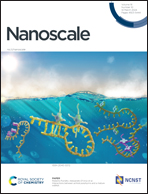Controlling Pt nanoparticle sintering by sub-monolayer MgO ALD thin films†
Abstract
Metal nanoparticle (NP) sintering is a major cause of catalyst deactivation, as NP growth reduces the surface area available for reaction. A promising route to halt sintering is to deposit a protective overcoat on the catalyst surface, followed by annealing to generate overlayer porosity for gas transport to the NPs. Yet, such a combined deposition-annealing approach lacks structural control over the cracked protection layer and the number of NP surface atoms available for reaction. Herein, we exploit the tailoring capabilities of atomic layer deposition (ALD) to deposit MgO overcoats on archetypal Pt NP catalysts with thicknesses ranging from sub-monolayers to nm-range thin films. Two different ALD processes are studied for the growth of MgO overcoats on Pt NPs anchored on a SiO2 support, using Mg(EtCp)2 and H2O, and Mg(TMHD)2 and O3, respectively. Spectroscopic ellipsometry and X-ray photoelectron spectroscopy measurements reveal significant growth on both SiO2 and Pt for the former process, while the latter exhibits a drastically lower growth per cycle with an initial chemical selectivity towards Pt. These differences in MgO growth characteristics have implications for the availability of uncoated Pt surface atoms at different stages of the ALD process, as probed by low energy ion scattering, and for the sintering behavior during O2 annealing, as monitored in situ with grazing incidence small angle X-ray scattering (in situ GISAXS). The Mg(TMHD)2–O3 ALD process enables exquisite coverage control allowing a balance between physically blocking the Pt surface to prevent sintering and keeping Pt surface atoms free for reaction. This approach avoids the need for post-annealing, hence also safeguarding the structural integrity of the as-deposited overcoat.



 Please wait while we load your content...
Please wait while we load your content...